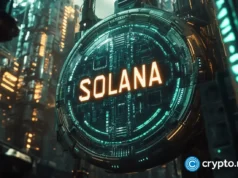
Europe’s new crypto rulebook is shaking things up as Tether’s not thrilled, but traditional players are finally paying attention. In a chat with crypto.news, Victoria Gago, co-CEO at European Blockchain Convention, a blockchain conference, shared why MiCA might be exactly what institutions were waiting for.
Summary
- MiCA’s arrival has split the crypto world, but Europe’s banks and startups see it as their cue to finally move ahead.
- The new rules are forcing a rethink of how institutions, regulators, and crypto-native firms work together, turning old pilot projects into real business plans.
- In an interview with crypto.news, Victoria Gago, co-CEO at the European Blockchain Convention conference, shared her take on how Europe’s clarity is changing the game and where the first real revenue is starting to show.
MiCA‘s here, but it’s facing mixed feelings. While the largest stablecoin issuer Tether’s not a fan, many European institutions seem to be treating it like a green light to move forward finally. So it’s a weird moment as rules are in place, but the game’s still being figured out.
In an exclusive interview with crypto.news, Victoria Gago, co-CEO at European Blockchain Convention, a global summit focused on blockchain, and emerging tech, broke down what’s really changing, who’s driving the momentum, and where she sees the real revenue coming from.
CN: MiCA is live, but do clearer rules actually give Europe an edge, or are firms still looking elsewhere? We’ve seen Tether. That makes me also wonder if the moves we are seeing are mostly driven by big banks bridging to Web3 or if smaller startups are taking the lead.
VG: MiCA absolutely gives Europe an edge, but not in the way most people expect. It’s not about being friendlier or looser — it’s about being predictable. When you have regulatory clarity, institutional capital can finally move. We’re seeing this play out in real-time at EBC, where the conversations have shifted from “should we?” to “how do we?”
On Tether’s opposition — that’s actually a validation of MiCA’s teeth. The framework requires real reserves, real transparency. Some players built their models on opacity, and MiCA challenges that. But look at the flip side: serious institutional players now have a clear pathway to operate in Europe without constantly looking over their shoulder.
As for who’s driving the moves — it’s actually both, and that’s what makes Europe unique. Yes, traditional banks like BBVA and Santander are experimenting with tokenization, blockchain rails, and retail crypto trading. But the real innovation is coming from the collision between the two: startups that understand crypto-native infrastructure partnering with banks that bring regulatory expertise and balance sheets. It’s not either/or — it’s the bridges being built between them that matter. At EBC11, we’re seeing this convergence accelerate, with our deal-making framework specifically designed to facilitate these partnerships.
CN: When banks talk about connecting to Web3, is that a real balance sheet change or just front-end experiments? Institutions say they are onboarding, but are they actually using crypto day to day, or mostly running pilots or relying on crypto firms to handle the crypto part?
VG: Most of what we’re seeing right now is infrastructure building, not full balance sheet transformation. Banks are running pilots, testing custody solutions, and exploring tokenized deposits. But here’s what’s changed: these aren’t science projects anymore. They’re strategic initiatives with real budgets and board-level attention.
The reality is that full integration takes time — these are institutions with decades-old core banking systems. They’re not going to flip a switch overnight. What we’re seeing is a methodical approach: custody partnerships with firms like Zodia, stablecoin experiments, and tokenization of traditional assets like bonds and real estate.
Are they relying on crypto firms to handle the crypto part? Absolutely, and they should be. You don’t see crypto companies building their own banking infrastructure from scratch — they partner with banks. The same logic applies in reverse. The smart play is collaboration, not competition.
Where I see this becoming real: payments infrastructure and cross-border settlement. That’s where the economic case is undeniable — faster, cheaper, 24/7 settlement. These aren’t experiments; they’re competitive necessities. The institutions that figure this out first will have a massive advantage, and Europe’s regulatory clarity via MiCA is enabling this to happen faster here than in markets still waiting for guidance.
CN: More broadly, with all this happening, where do you see real revenue starting to show up first in Europe: tokenized assets, custody services, or payments?
VG: The answer is already here — it’s custody services and payments infrastructure, happening in parallel.
Custody is generating real revenue right now because it’s the essential infrastructure layer. Every institutional player entering this space needs secure custody, and we’re seeing European providers building significant businesses around this. The revenue model is clear: basis points on assets under custody. It’s not speculative — it’s recurring revenue from regulated entities. At EBC11, we have leaders from Zodia Custody, GK8 by Galaxy, and major banking players speaking precisely because this infrastructure is mature and revenue-generating.
Payments and stablecoin infrastructure are equally live. We’re seeing real transaction volume in cross-border settlements, treasury management, and corporate payment rails. When you have speakers from Visa, Mastercard, JPMorgan, and Stripe all at one event, you know this isn’t pilot season anymore — these are scaled operations processing real transactions.
Tokenized assets — real estate, bonds, private equity — that’s where the massive potential lies, but it’s a 2026-2027 story, not 2025. The legal frameworks are coming together through MiCA, institutions like BNP Paribas and Union Investment are actively building in this space, but we need more secondary market liquidity and investor comfort before this becomes a major revenue driver.
We expect to see the biggest revenue growth over the next 18 months in the infrastructure layer, specifically in custody, compliance tooling, and payment rails. These are the picks and shovels of the digital asset gold rush, and they’re generating cash flow today.
What we’re building at EBC11 reflects this reality — our deal-making framework connects founders building this infrastructure with the VCs and institutions ready to deploy capital into proven revenue models, not just speculation. With over 100 sessions and speakers from OKX, Bitpanda, Standard Chartered, Morgan Stanley, and major European banks, we’re bringing together the people actually building and funding this revenue-generating infrastructure. Europe isn’t falling behind — we’re building the foundation that will support this industry for the next decade.











